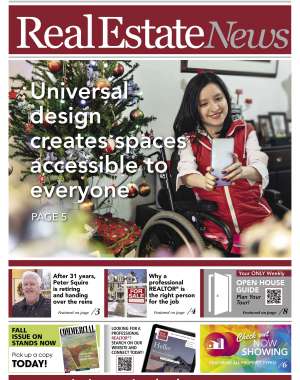International Day of Persons with Disabilities is December 3, so what better time to talk about accessability and universal design?
Covering everything from furnishings and finishing touches, universal design addresses the entire spectrum of needs for anyone who lives in and uses a space. One in five Canadians identify as having at least one disability, according to Statistics Canada, and as we age the chance of developing mobility issues increases.
Designing accessible spaces that are convenient for everyone provides more housing options for individuals with mobility issues, enabling us to age in place, remain independent, and stay in our homes longer.
“Universal design enables access and function for all people regardless of size, shape, ability or disability,” explains occupational therapist Jason Dalton, who is also chair of the board for the Universal
Design Network (UDNC) of Canada.
When building or renovating, most universal design features in a home add no or very little extra cost, says Dalton.
“It can even save you money incorporating universal design features in your home during the construction or renovation stage versus retrofitting down the road,” he adds.
Plan it now, even if you don’t need it until later
Even if you’re young and healthy, it’s a good idea to keep universal design in mind, says Dalton.
“A survey by the National Institute of Ageing (at Toronto Metropolitan University) and TELUS Health found that 91% of Canadians of all ages, and almost 100% of Canadians 65 years of age and older, say they plan on supporting themselves to live safely and independently in their own home as long as possible,” he explains.
“We’re an injury, disease, or age away from a disability. Living in a home with accessibility features such as a level, no-step main entrance or an accessible bathroom will support you throughout your lifespan.”
How to incorporate universal design features into your new or renovated home
Accessibility features are considered to be ergonomic enhancements for us all — even if you don’t have any mobility issues. There are plenty of simple, affordable ways to introduce accessible elements into your space, notes Dalton. For example, installing lever handles will reduce the effort required to open doors, while task lighting under your kitchen cabinets allows you to see better when preparing food.
In your design plans, ask for wider doors that a wheelchair could get through. For multi-level homes, request your closets are stacked on top of each other; this will allow space for an elevator in the future if needed.
If you’re building, consider installing a walk-in shower or bath with a bench. This feature makes it easier to get in and out of the shower and minimizes the risk of falling. Grab bars in the bathroom also reduce the risk of injury on slippery floors. Floating vanities leave lots of space for a wheelchair but are also a sleek design feature in contemporary homes.
You could also consider things like:
• non-slip flooring for more confident mobility;
• windows with low sills so those in wheelchairs can see outside;
• a bench or ledge outside so you can set things down to open the door;
• placing light switches and controls within reach of the bed so those with limited mobility can be more independent;
• have a full bathroom — including the shower and tub — located on the main floor;
• locate the laundry room on the same floor as the main living areas;
• opt for front-loading laundry machines; and,
• find railings for balconies and decks that don’t block the view while seated.
There are also some temporary ways you can make your home more accessible for those who may be visiting. Temporary wheelchair ramps are available to purchase, and they fold up nicely for storage in your garage. These can also be helpful for friends and family who are visiting with young kids and might have strollers they’re bringing inside. You can also find adhesive or suction grab bars for the shower if you have people staying for an extended period of time, but you’re unable to drill into your shower. If you’re wondering how you can make your home accessible for visitors who may require it, you can always ask them what they’d benefit from.
The UDNC website at universaldesign.ca offers many resources and tips for how to plan for and incorporate universal design elements in your home. While house-hunting, ask your REALTOR® to include properties that either have universal design features or can be adapted to include accessible options down the road, as well as nearby accessible parks and community centres. Together, you’ll find the perfect home to cater to all the stages of your life.
— Realtor.ca



